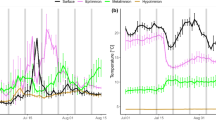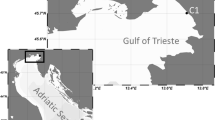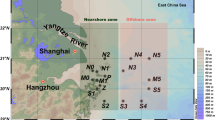Abstract
A time-series sediment trap deployment was carried out in the marginal ice zone (MIZ) of the Antarctic Ocean (64°42′ S, 139°58′E; sea depth of 2930 m), during the austral summer. Cylindrical fecal pellets were the predominant sinking particles at 537 m in the middle of January and most of them disappeared below that depth, the loss of which were 25.3 mg C m−2 day−1 in the depth range of 537–796 m. Small-sized sinking particles other than fecal pellets increased in that depth range. Analyses of fecal pellets for remnant DNA corresponding to 16S mitochondrial RNA and 28S ribosomal RNA suggested that the large cylindrical fecal pellets at 537 m were produced by Antarctic krill (Euphausia superba) and copepods. According to the presence of the DNA associated with sinking particles, E. superba fecal pellets rapidly disappeared below 537 m, while copepod fecal pellets still remained in the mesopelagic and bathypelagic layers. Small-sized amorphous sinking particles at 537 m also contained E. superba- and copepod-derived DNA. The abundance of trap-collected copepods (Oithona spp. and Oncaea spp.) which are known to be coprophagous increased at 796 m where many fecal pellets disappeared. We suggest that those rapidly sinking pellets were fragmented by copepods with intensified coprorhexy activity (fragmentation of fecal pellets) in the mesopelagic layers, reducing their sinking rates. These smaller and slower sinking particles can be important food sources for detritivorus or coprophagous animals in mesopelagic and bathypelagic layers in the MIZ.
Similar content being viewed by others
References
Angel, M. V. (1984): Detrital organic fluxes through pelagic ecosystem. p. 475-516. In Flow Energy and Materials in Marine Ecosystems: Theory and Practice, ed. by M. J. R. Fasham, Plenum Press, New York.
Ayukai, T. (1987): Rate of filtering of fecal pellets by Acartia omorii(Copepoda; Calanoida). J. Oceanogr. Soc. Japan., 42, 487-489.
Bathmann, U., G. Fischer, P. J. M Üller and D. Gerdes (1991): Short-term variations in particulate matter sedimentation off Kapp Norvegia, Weddell Sea, Antarctica: relationship to water mass advection, ice cover, plankton biomass and feeding activity. Polar Biol., 11, 185-195.
Bodungen, B. von, G. Fischer, E.-M. N Öthig and G. Wefer (1987): Sedimentation of krill faeces during spring development of phytoplankton in Bransfield Strait, Antarctica. Mitteilungen aus dem Geologisch-Pal äontologischen Institut der Universit ät, 62, 243-257.
Bruland, K. W. and M. W. Silver (1981): Sinking rates of fecal pellets from gelatinous zooplankton (Salps, Pteropods, Doliolids). Mar. Biol., 63, 295-300.
Conover, R. J. and M. Huntley (1991): Copepods in ice covered seas-distribution, adaptations to seasonally limited food, metabolism, growth patterns and life cycle strategies in polar seas. J. Mar. Sys., 2, 1-41.
Fowler, S. W. and F. Small (1972): Sinking rates of euphausiid fecal pellets. Limnol. Oceanogr., 17, 293-296.
Fransz, H. G. (1988): Vernal abundance, structure and development of epipelagic copepod populations of the Eastern Weddell Sea (Antarctica). Polar Biol., 9, 107-114.
Fukamachi, Y., M. Wakatsuchi, K. Taira, S. Kitagawa, S. Ushio, A. Yakahashi, K. Oikawa, T. Furukawa, H. Yoritaka, M. Fukuchi and T. Yamanouchi (2000): Seasonal variability of bottom water properties off Ad élie Land Antarctica. J. Geophys. Res., 105, 6351-6540.
Gauld, D. T. (1957): A peritrophic membrane in calanoid copepods. Nature, 179, 325-326.
Gersonde, R. and G. Wefer (1987): Sedimentation of biogenic siliceous particles in Antarctic waters from the Atlantic sector. Mar. Micropaleont, 11, 311-332.
Gonz ález, H. E. (1992): The distribution and abundance of krill faecal material and oval pellets in the Scotia and Weddell Sea (Antarctica) and their role in particle flux. Polar Biol., 12, 81-91.
Gonz ález, H. E. and V. Smetacek (1994): The possible role of the cyclopoid Oithonain retarding vertical flux of zooplankton faecal material. Mar. Ecol. Prog. Ser., 113, 233-246.
Gonz ález, H. E., F. Kurbjewit and U. V. Bathmann (1994): Occurrence of cyclopoid copepods and faecal material in the Halley-Bay Region, Antarctica, during January-February 1991. Polar Biol., 14, 331-342.
Hart, T. J. (1934): On the phytoplankton of the southeast Atlantic and the Bellingshausen Sea 1929-1931. Discovery Report, 8, 1-268.
Honjo, S. (1976): Coccoliths: production, transportation and sedimentation. Mar. Micropaleont, 1, 65-79.
Honjo, S. and K. W. Doherty (1988): Large aperture time-series sediment traps; design objectives, construction and application. Deep-Sea Res., 35, 133-149.
Honjo, S. and M. R. Roman (1978): Marine copepod fecal pellets: production, preservation and sedimentation. J. Mar. Res., 36, 45-57.
Johannes, R. E. and M. Satomi (1966): Composition and nutritive value of fecal pellets of marine crustacean. Limnol. Oceanogr., 11, 191-197.
Kawaguchi, K. (1996): Preliminary Report of the R/V Hakuho maru Cruise KH94-4. Southern Ocean Expedition. Ocean Research Institute University of Tokyo, Tokyo, p. 1-135.
Knauer, G. K., J. H. Martin and K. W. Bruland (1979): Fluxes of particulate carbon, nitrogen, and phosphorus in the upper water column of the northeast Pacific. Deep-Sea Res., 26, 97-108.
Komar, P. D., A. P. Morse, L. E. Small and S. W. Fowler (1981): An analysis of sinking rates of natural copepod and euphausiid fecal pellets. Limnol. Oceanogr., 26, 172-180.
Lampitt, R. S., T. Noji and B. von Bodnugen (1990): What happens to zooplankton faecal pellets? implications for material flux. Mar. Biol., 104, 15-23.
Marr, J. W. S. (1962): The natural history of geography of the Antarctic krill (Euphausia superbaDana). Discovery Report, 32, 33-464.
Marshall, S. M. and A. P. Orr (1955): The Biology of a Marine Copepod. Calanus finmarchicus (Gunnerus). Oliver and Boyd, London, 188 pp.
Martens, P. (1978): Faecal pellets. Fich. Ident. Zooplankton, 162, 1-4.
Metz, C. (1995): Seasonal variation in the distribution and abundance of Oithonaand Oncaeaspecies (Copepoda, Crustacea) in the southeastern Weddell Sea, Antarctica. Polar Biol., 15, 187-194.
Nishida, S. and S. Ohtsuka (1997): Ultrastructure of the mouthpart sensory setae in mesopelagic copepods of the family Scolecitrichidae. Plankton Biol. Ecol., 44, 81-90.
Noji, T. T., K. W. Estep, F. Macintyre and F. Norrbin (1991): Image analysis of fecal material grazed upon by three species of copepods: evidence for coprorhexy, copprophagy and coprochaly. J. Mar. Biol. Ass. U.K., 71, 465-480.
Nott, J. A., L. J. Mavin, E. D. S. Corner and S. C. M. O'Hara (1985): Cyclical contributions of the digestive epithelium to fecal pellet formation by the copepod Calanus helgolandicus. Mar. Biol., 89, 271-279.
Ohtsuka, S. and N. Kubo (1991): Larvaceans and their houses as important food for some pelagic copepods. Proceedings of the 4th International Conference on Copepoda. Bull. Plankton Soc. Japan Spec. Vol., 535-551.
Paffenh Öfer, G. A. (1993): On the ecology of marine cyclopoid copepods (Crustacea, Copepoda). J. Plankton Res., 15, 37-55.
Paffenh Öfer, G. A. and S. C. Knowles (1979): Ecological implications of fecal pellet size, production and consumption by copepods. J. Mar. Res., 37, 35-49.
Pilskaln, C. H. and S. Honjo (1987): The fecal pellet fraction of biogeochemical particle fluxes to the deep sea. Global Biogeochem. Cycles, 1, 31-48.
Sasaki, H. and S. Nishizawa (1989): Downward flux of zooplankton fecal pellets in the upper 2000m water column of the Izu Trench, western North Pacific. J. Oceanogr. Soc. Japan, 45, 258-269.
Sasaki, H., H. Hattori and S. Nishizawa (1988): Downward flux of particulate organic matter and vertical distribution of calanoid copepods in the Oyashio Water in summer. Deep-Sea Res., 35, 505-515.
Sasaki, H., H. Hattori, O. Matsuda, A. Tanimura and M. Fukuchi (1993): Variability in the flux of rapidly sinking particles at the Chirikov Basin of the northern Bering Sea in summer 1988. La mer, 31, 19-29.
Sasaki, H., H. Suzuki, M. Takayama, K. Suzuki, N. Handa, S. Kudho and M. Fukuchi (1997): Sporadic increase of particle sedimentation at the ice edge of the Antarctic Ocean during the austral summer 1994-1995. Proc. NIPR Symp. Polar Biol., 10, 50-55.
Schnack-Schiel, S. B., W. Hagen and E. Mizdalski (1991): Seasonal comparison of Calanoides acutusand Calanus propinquus(Copepoda: Calanoida) in the southeastern Weddell Sea, Antartica. Mar. Ecol. Prog. Ser., 7017–27.
Small, L. F., S. W. Fowler and M. Y. Ünl Ü (1979): Sinking rates of natural copepod fecal pellets. Mar. Biol., 51, 233-241.
Smayda, T. J. (1970): The suspension and sinking of phytoplankton in the sea. Oceanographic Mar. Biol. Annu. Rev., 8, 353-414.
Smetacek, V., R. Scharek and E.-M. N Öthig (1990): Seasonal and regional variation in the pelagial and its relationship to the life history cycle of krill. p. 103-114. In Antarctic Ecosystems Ecological Change and Conservation, ed. by K. R. Kerry and G. Hempel, Springer-Verlag, Berlin Heidelberg.
Suzuki, H., H. Sasaki, K. Shibata and B. H. Tamate (1995): PCR amplification of the 28S ribosomal gene in calanoid copepods and its application to the detection of copepod DNA in marine detritus. Bull. Plankton Soc. Japan, 42, 163-167.
Suzuki, H., H. Sasaki and B. H. Tamate (2000): Identification of fecal pellet producers through copepod-derived DNA sequence. Bull. Plankton Soc. Japan, 47, 136-139 (in Japanese with English abstract).
Suzuki, H., H. Sasaki and M. Fukuchi (2001): Short-term variability in the flux of rapidly sinking particles in the Antarctic marginal ice zone. Polar Biol., 24, 697-705.
Taguchi, S. (1998): Net zooplankton and the biological pump off Sanriku, Japan. J. Oceanogr. Soc. Japan, 54, 573-582.
Tanoue, E. and S. Hara (1986): Ecological implications of fecal pellets produced by the Antarctic krill Euphausia superbain the Antarctic Ocean. Mar. Biol., 91, 359-369.
Turner, J. T. and J. G. Ferrante (1979): Zooplankton fecal pellets in aquatic ecosystems. Bio Science, 29, 670-677.
Urr ère, M. A. and G. A. Knauer (1981): Zooplankton fecal pellet fluxes and vertical transport of particulate organic material in the pelagic environment. J. Plankton Res., 3, 369-387.
Veth, C., C. Lancelot and S. Ober (1992): On processes determining the vertical stability of surface waters in marginal ice zone of the northern-western Weddell Sea and their relationship with phytoplankton bloom development. Polar Biol., 12, 237-243.
Wefer, G. (1989): Particle flux in the ocean: effects of epispodic production. p. 139-154. In Productivity of the Ocean: Present and Past, ed. by W. H. Berger, V. S. Smetacek and G. Wefer, John Wiley & Sons Ltd., Chichester, New York, Brisbane, Toronto, Singapore.
Wefer, G., G. Fischer, D. F Üetterer and R. Gersonde (1988): Seasonal particle flux in the Bransfield Strait, Antarctica. Deep-Sea Res., 35, 891-898.
Wright, D. K. and M. Manos (1991): Parafin houmai shita shiryo karano kakusan no tyusyutsu. p. 135-139. In PCR Protocols, A Guide to Methods and Applications, ed. by A. Michael, D. H. Gelfand, J. J. Snisky and T. J. White, Harcout Brace Jovanovich, Japan (in Japanese).
Yamada, S. and A. Kawamura (1987): Some characteristics of the zooplankton distribution in the Prydz Bay region of the Indian Sector of the Antarctic Ocean in summer of 1983/ 84. Mem. Natl. Inst. Polar Res. Spec. Issue, 44, 86-95.
Author information
Authors and Affiliations
Rights and permissions
About this article
Cite this article
Suzuki, H., Sasaki, H. & Fukuchi, M. Loss Processes of Sinking Fecal Pellets of Zooplankton in the Mesopelagic Layers of the Antarctic Marginal Ice Zone. Journal of Oceanography 59, 809–818 (2003). https://doi.org/10.1023/B:JOCE.0000009572.08048.0d
Issue Date:
DOI: https://doi.org/10.1023/B:JOCE.0000009572.08048.0d




